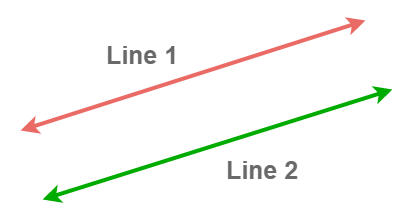
|
|
Constructing a line parallel to a given line through a given point is a fundamental task in Geometry. The lines that do not have a common meeting point in the same plane, however far they are extended, are called Parallel lines. To understand this topic of the parallel line clearly, you can take examples of railway tracks, zebra crossings, etc. The process of constructing a parallel line can be accomplished by using a compass, a scale, and some other tools of Geometry. The objective of this article is to discuss the process of drawing a second line through a given point that will never intersect the original line, thereby creating a parallel line. What is a Parallel Line?
The concept of parallel lines is rooted in the Euclidian Geometry. Parallel lines are always the same distance apart and share the same slope. It is an important concept not only in the field of Geometry but also in various fields such as engineering, architecture, art etc. The following figure represents parallel lines: Steps to Construct a Parallel Line to a Given Line Through a Given PointThis construction method involves transferring a distance and an angle from the given line to the new line and to ensure that the new line maintains the same orientation as the original line, we use compass. This process involves the properties of corresponding angles and equidistant points. To construct a line parallel to other line from a given or an external point we require a scale and a compass and some other tools of Geometry and we have to go through the following steps: Step 1: Lets take a line segment AB and a point P, not on it.  Step 1 Step 2: Take a point X on the line AB and connect PX with a straight line. With X as a center take any radius and draw an arc that intersects the line segment AB at C and PX at D  Step 2 Step 3: With P as a center, take the same radius of the arc drawn from the point X to draw an arc on P also. The arc intersects the line PX at E.  Step 3 Step 4: Take a compass to measure the length of CD. Now with E as a center, the compass opened with the same radius or length of CD, draw an arc intersecting the previous arc at F.  Step 4 Step 5: Draw a line YZ passing through F and P points.  Step 5 Thus the line segment YZ is the required line parallel to the line segment AB and passes through the external point P. ∴ YZ ║ AB Proof of MethodLook at the following figure, 
We see that ∠DXC = ∠FPE {∵ we have drawn them with same radius} Now for YZ and AB line segments, ∠DXC and ∠FPE are corresponding interior angles, thus they are equal, ∴ YZ ║ AB……(Proved) Also Read Frequently Asked QuestionsWhat is the formula for parallel lines?
Which lines are called parallel in class 10 syllabus?
How do you write an equation parallel to a given line?
What are the examples of parallel lines?
Can a line be parallel to a line?
Are parallel lines have equal distance?
|
Reffered: https://www.geeksforgeeks.org
| Mathematics |
| Related |
|---|
| |
| |
| |
| |
| |
Type: | Geek |
Category: | Coding |
Sub Category: | Tutorial |
Uploaded by: | Admin |
Views: | 20 |